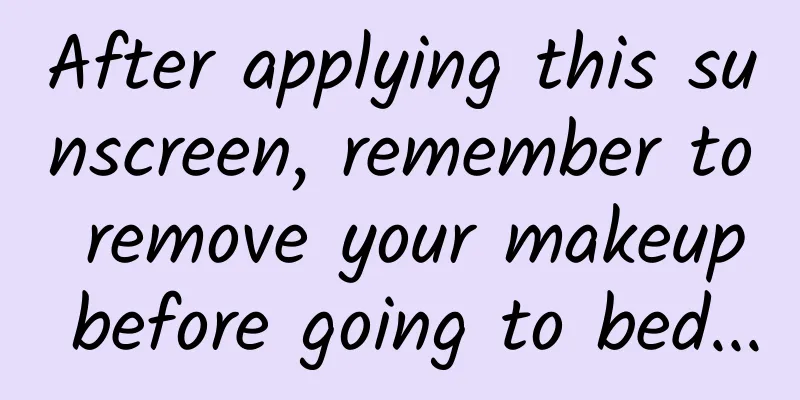After applying this sunscreen, remember to remove your makeup before going to bed...

|
Did you put on sunscreen when going out on May Day? As the weather gets hotter, people are paying more and more attention to sun protection. When we search for words related to "sun protection" on the Internet, we often see people wondering: "Can I use normal cleansing products to wash off the sunscreen after applying it?" "Remove makeup? Or not?" I believe many of my friends have struggled with this issue or are struggling with it. Removing makeup is inevitably troublesome, and they are also worried about over-cleansing, which is not only in vain but also may damage the skin; not removing makeup is also worried that it is not cleaned thoroughly and may cause clogged pores, folliculitis, acne and other problems. Today we are going to discuss this big question - "To be? Or not to be? Remove makeup? Or not remove makeup?" Do you know the classification of sunscreen products? There are many kinds of sunscreen products on the market, including clothing-type sunscreen products such as sun-protective clothing and masks, as well as skin care products of different textures such as oils, creams, lotions, and sprays. When we use skin care sunscreen products such as sunscreen, the question of whether we need to remove makeup arises. Image source: pexels The ingredients that play a sun protection role in skin care sunscreen products are called sunscreens. Sunscreens can be divided into inorganic sunscreens and organic sunscreens. TiO2 and ZnO particles are currently the most common inorganic sunscreens, which are what we often call physical sunscreens. These particles are insoluble particles and powders that can shield ultraviolet rays. In other words, when there is a relatively uniform layer of inorganic sunscreen on the surface of our skin, the ultraviolet rays in the sun will not be directly absorbed by our skin, but will be reflected, refracted and scattered, so the damage of ultraviolet rays in the sun to our skin is greatly weakened. The counterpart of inorganic sunscreens is organic sunscreens, which are what we often call chemical sunscreens. There are many types of inorganic sunscreens that are common at present, such as benzophenones, camphor derivatives, methane derivatives and other substances. Unlike particles such as TiO2 and ZnO, these substances play an absorbing role. During the working process, the chemical structure of these substances can change to absorb ultraviolet rays, and finally release heat to protect the skin from damage. According to statistical analysis of Mintel data, the frequency of sunscreen agents used in new global sunscreen products in the past three years is ranked as follows: ethylhexyl methoxycinnamate, titanium dioxide, diethylaminohydroxybenzoyl hexyl benzoate, bis-ethylhexyloxyphenol methoxyphenyl triazine, ethylhexyl salicylate, octocrylene, butyl methoxydibenzoylmethane, zinc oxide, 4-methylbenzylidene camphor, ethylhexyl triazone, methylene bis-benzotriazolyl tetramethylbutylphenol, homosalate, phenylbenzimidazole sulfonic acid, benzophenone-3, polysilicone-15, drometrizole trisiloxane, diethylhexyl butyramido triazone, etc. Currently, skin care sunscreen products are divided into physical sunscreen products, chemical sunscreen products, and physicochemical sunscreen products that contain both physical and chemical sunscreens according to their main types of sunscreen agents. To uninstall or not to uninstall? Now that we have learned some basic knowledge about the products involved, let’s get back to our original question – “to uninstall or not to uninstall”. There are many different opinions on this topic. One widely circulated saying is "judge based on whether the sunscreen product is physical or chemical", but this statement is actually inaccurate. The physical sunscreen products, chemical sunscreen products and physicochemical sunscreen products currently on the market have a low oil content and are easier to emulsify. They can be cleaned with warm water and ordinary cleansing products such as facial cleansers. Image source: pexels So when do you need to remove makeup? The answer is that we only need to remove makeup when we use sunscreen products marked "waterproof and sweatproof". In order to achieve the purpose of water-proof and sweat-proof, sunscreen products need to add various film-forming agents. After adding film-forming agents, sunscreen products will not fall off the skin easily. The presence of film-forming agents brings certain difficulties to cleaning. Therefore, using only ordinary cleansing products cannot guarantee that sunscreen products are cleaned. A milder makeup remover is needed for cleaning. However, since the facial cleansing products on the market are different and have different cleaning powers, some friends may still have some doubts and are not sure whether the facial cleansing products they use can clean the sunscreen products. You can do a very simple experiment to judge. The steps are as follows: a) Take an appropriate amount of sunscreen product and apply it evenly on the back of your clean hands or other parts of your skin; b) Wait for about 10 minutes for the sunscreen product to form a film; c) Cleaning the skin part of the experimental subject using facial cleansers and warm water, and drying the skin part after cleaning; d) Rinse and dry the skin with water. If the water on the skin forms droplets or flows in strands, it means it is not cleaned thoroughly. If the water flows normally on the skin (consistent with the state of clean skin of other subjects not included in the experiment), it means it is cleaned thoroughly. Why do we need sunscreen? Many people choose sunscreen to prevent tanning and improve the beauty of their skin. So, is sunscreen really just for whitening? Do only people who need whitening need to do a good job of sunscreen? Sun protection mainly protects against the ultraviolet rays in sunlight, and ultraviolet rays can be further divided according to their wavelength. When the wavelength is 320-400nm, it can be called long-wave ultraviolet rays; when the wavelength is 280-320nm, it is called medium-wave ultraviolet rays; when the wavelength range is 100-280nm, it is called short-wave ultraviolet rays. The characteristics and hazards of these three types of ultraviolet rays are shown in the figure below. Short-wave ultraviolet rays cannot penetrate the ozone layer and will not cause harm to our skin. What we usually call sun protection is to prevent the harm of long-wave ultraviolet rays and medium-wave ultraviolet rays to our skin. (Image source: Reference 4) The benefits of sun protection are not only whitening, but also protecting our skin and making it healthier. Each of us should actively do a good job of sun protection. Ultraviolet rays are getting stronger and stronger, so let us pay attention to sun protection and do a good job of sun protection. References [1]Xie Xin, Wang Weihao, Liu Huanyu, Sun Mengmeng, Li Qinyuan, Jia Lufan, Meng Tao. Study on Pickering emulsion stabilized by Alg@TiO_2 microspheres as sunscreen ingredients[J/OL]. Daily Chemical Industry: 1-8[2022-02-26]. [2] Xiao Xiong, Zhou Demian, Chen Zhihui, Chen Zunfeng, Yu Han. Formulation design of sunscreen products - matching of sunscreen agents[J]. Guangdong Chemical Industry, 2021, 48(15): 71-74. [3] Zhang Xueyi, Jin Xin, Li Li, Xu Xiaoqing. Study on the composition and effects of commonly used sunscreen products on the market[J]. Jiangsu Science and Technology Information, 2019, 36(24): 77-80. [4] Wang Jianqin. Scientific sun protection revealed[J]. Population and Health, 2019(08):92-94. [5] Qian Huan. Delaying aging and preventing skin cancer and sun protection are tasks we should all do [J]. Decision Exploration (Part 1), 2019(08):88. END Review expert: Zhang Yuhong, associate chief physician of dermatology, Zhengzhou Central Hospital Affiliated to Zhengzhou University. Editor/Heart and Paper |
<<: What changes will occur in the body within 72 hours after alcohol enters the body?
>>: ALS patient tweets: Hello, world!
Recommend
User growth and basic process!
However, today's article wants to do one thin...
Toona sinensis, Houttuynia cordata, and Durian, which one has the top 1 stink?
Audit expert: Shi Jun Doctor of Botany, well-know...
Car companies start "battery equipment competition", CATL's long-life batteries become "hot cakes"
In the new energy vehicle circle, the topics of &...
The truth about the 6.18 promotion: users are anxious, and the conversion rate goes up
The truth about promotions is: when users are anx...
7 tips and analysis methods for ToB content operations!
This article analyzes competitors from three pers...
How to optimize conversion rate through channel conversion model?
Advertising guru John Wanamaker once said, "...
Information flow advertising: budget 400, keywords 2W+, how to promote?
This week, the editor has sorted out several diff...
Guizhou’s journey is to the top of thousands of mountains!
This may be the fastest changing province in Chin...
APP promotion tips: 100,000 yuan brings 20 million users
Last time, I wrote an article titled "How to...
The conversion rate of information flow is only 10%, so where does the remaining 90% of traffic go?
The most painful thing in marketing promotion is:...
Interpreting ASP.NET 5 & MVC6 Series (10): Controller and Action
We know that in MVC5 and previous versions, the l...
Soul product analysis!
Contemporary young people use social software - y...
IOS witchcraft: the unkillable background & monitoring process
Implementation without jailbreak: Startup: After ...
Urinary Health Day丨Be careful! When urine turns yellow, your body is "reporting" these things to you
Experts in this article: Wang Bin, Department of ...
From beginners to masters of self-media: Basic class + advanced class + editing tutorial (with common self-media software and common websites) worth 4580 yuan
From beginners to masters of self-media: basic cl...









